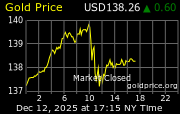Correction is expected to be temporary as several macroeconomic drivers of higher gold prices reassert themselves
The gold price tumbled $36.45, or 2.1%, to $1,669.21 per ounce Tuesday morning as ongoing sovereign debt concerns in Greece led to U.S. dollar strength and widespread liquidation on Wall Street. With its decline, the price of gold fell to its lowest level since January 24 and cut its year-to-date gain to 6.7%. Silver retreated alongside the gold price, by $1.34, or 3.9%, to $32.70 per ounce.
Commenting on the outlook for gold, analysts at Commerzbank wrote in a note to clients that “There is additional scope for (a) correction” in the price of gold and silver. The firm based its cautious short-term stance on the view that many fund managers who accumulated positions earlier this year may continue exit the trade. However, Commerzbank later contended that any further correction is expected to be temporary as several macroeconomic drivers of higher gold prices reassert themselves.
Richard Davis, a fund manager at Blackrock – the world’s largest asset management company – recently discussed the economic factors likely to push gold prices upward in the months ahead. “What is more important with regards to gold is real interest rates are negative and this is the key issue that we have to look at,” he stated in remarks to Reuters. “(A switch in) this factor will probably signal the end of the bull market in gold and our view is that we are still some way from this point because inflation is a problem and interest rates are very low.”
As for specific gold price targets, Davis noted that “There is quite a distinct possibility that we will see highs above $1,900.” Although he did not identify a time period for his prediction, Davis added that “It won’t take it a lot to get back to those levels and I certainly wouldn’t be surprised to see gold going to a new high and going to $2,000.”
Commenting on the outlook for gold, analysts at Commerzbank wrote in a note to clients that “There is additional scope for (a) correction” in the price of gold and silver. The firm based its cautious short-term stance on the view that many fund managers who accumulated positions earlier this year may continue exit the trade. However, Commerzbank later contended that any further correction is expected to be temporary as several macroeconomic drivers of higher gold prices reassert themselves.
Richard Davis, a fund manager at Blackrock – the world’s largest asset management company – recently discussed the economic factors likely to push gold prices upward in the months ahead. “What is more important with regards to gold is real interest rates are negative and this is the key issue that we have to look at,” he stated in remarks to Reuters. “(A switch in) this factor will probably signal the end of the bull market in gold and our view is that we are still some way from this point because inflation is a problem and interest rates are very low.”
As for specific gold price targets, Davis noted that “There is quite a distinct possibility that we will see highs above $1,900.” Although he did not identify a time period for his prediction, Davis added that “It won’t take it a lot to get back to those levels and I certainly wouldn’t be surprised to see gold going to a new high and going to $2,000.”















0 comments:
Post a Comment